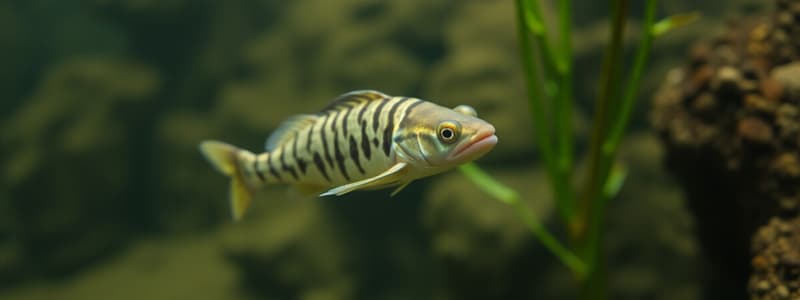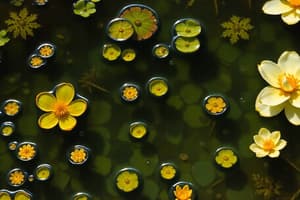Podcast
Questions and Answers
[Blank] biology is the study of aquatic life in marine, freshwater, and brackish-water habitats.
[Blank] biology is the study of aquatic life in marine, freshwater, and brackish-water habitats.
Aquatic
Egypt's aquatic ecosystems include marine areas like the Red Sea and Mediterranean Sea, as well as freshwater areas like the River Nile, lakes, and ______.
Egypt's aquatic ecosystems include marine areas like the Red Sea and Mediterranean Sea, as well as freshwater areas like the River Nile, lakes, and ______.
ponds
The aquatic biomes unique to Egyptian waters include benthic and pelagic systems, coral reefs, and ______.
The aquatic biomes unique to Egyptian waters include benthic and pelagic systems, coral reefs, and ______.
mangroves
Understanding how freshwater ecosystems function involves studying the physical, chemical, and biological components of lentic and ______ systems.
Understanding how freshwater ecosystems function involves studying the physical, chemical, and biological components of lentic and ______ systems.
An aquatic biology course is designed to provide ______ for students wishing to pursue careers in aquatic, environmental, and ecological fields.
An aquatic biology course is designed to provide ______ for students wishing to pursue careers in aquatic, environmental, and ecological fields.
Freshwater biology is the ______ biological study of freshwater ecosystems and is a branch of Limnology.
Freshwater biology is the ______ biological study of freshwater ecosystems and is a branch of Limnology.
Freshwater biology seeks to understand the ______ between living organisms in freshwater and their physical and chemical environment.
Freshwater biology seeks to understand the ______ between living organisms in freshwater and their physical and chemical environment.
[Blank] is the study of freshwater ecosystems and is also referred to as freshwater science.
[Blank] is the study of freshwater ecosystems and is also referred to as freshwater science.
Lentic systems refer to standing water, while ______ systems refer to moving water.
Lentic systems refer to standing water, while ______ systems refer to moving water.
Limnology, also called freshwater ______, is the study of inland waters and a division of ecology or environmental science.
Limnology, also called freshwater ______, is the study of inland waters and a division of ecology or environmental science.
Limnology covers the biological, chemical,physical, ______, and other attributes of inland waters, both fresh and salty, natural or man-made.
Limnology covers the biological, chemical,physical, ______, and other attributes of inland waters, both fresh and salty, natural or man-made.
[Blank] can be defined as a large area characterized by its vegetation, soil, climate, and wildlife
[Blank] can be defined as a large area characterized by its vegetation, soil, climate, and wildlife
Aquatic biomes can be further divided into freshwater biomes that have a salinity of less than 1% and ______ biomes, which cover close to three-quarters of the Earth's surface.
Aquatic biomes can be further divided into freshwater biomes that have a salinity of less than 1% and ______ biomes, which cover close to three-quarters of the Earth's surface.
Ecosystems include a community of living (biotic) organisms ______ with their non-living (abiotic) environment.
Ecosystems include a community of living (biotic) organisms ______ with their non-living (abiotic) environment.
Abiotic components of an ecosystem consist of the ______ aspects of the environment that determine what life forms can thrive.
Abiotic components of an ecosystem consist of the ______ aspects of the environment that determine what life forms can thrive.
[Blank] is the layout of the land in terms of elevation, which influences the amount of water and moisture in the air and soil, which, in turn, affect rainfall.
[Blank] is the layout of the land in terms of elevation, which influences the amount of water and moisture in the air and soil, which, in turn, affect rainfall.
The ______ components of an ecosystem are the life forms that inhabit it, aiding in the transfer and cycle of energy.
The ______ components of an ecosystem are the life forms that inhabit it, aiding in the transfer and cycle of energy.
Abiotic factors are the physical, or ______, factors that shape an ecosystem, such as rocks, climate, and sunlight.
Abiotic factors are the physical, or ______, factors that shape an ecosystem, such as rocks, climate, and sunlight.
Freshwater ecosystems include ______ such as pools, ponds, and lakes.
Freshwater ecosystems include ______ such as pools, ponds, and lakes.
Freshwater ecosystems include ______ or faster moving water, for example Streams and Rivers.
Freshwater ecosystems include ______ or faster moving water, for example Streams and Rivers.
Flashcards
Freshwater Biology
Freshwater Biology
The scientific study of freshwater ecosystems, a branch of Limnology, exploring the relationships between living organisms and their physical/chemical environment.
Limnology
Limnology
The study of inland waters, covering biological, chemical, physical, and geological attributes of fresh and salty, natural or man-made waters, including lakes, ponds, rivers, and wetlands.
Hydrobiology
Hydrobiology
A branch of biology dealing with aquatic ecosystems. It studies life in the water.
Oligohaline
Oligohaline
Signup and view all the flashcards
Mesohaline
Mesohaline
Signup and view all the flashcards
Metahaline
Metahaline
Signup and view all the flashcards
Biome
Biome
Signup and view all the flashcards
Aquatic Biomes
Aquatic Biomes
Signup and view all the flashcards
Ecosystem
Ecosystem
Signup and view all the flashcards
Abiotic Factors
Abiotic Factors
Signup and view all the flashcards
Biotic Factors
Biotic Factors
Signup and view all the flashcards
Lentic Ecosystems
Lentic Ecosystems
Signup and view all the flashcards
Lotic Ecosystems
Lotic Ecosystems
Signup and view all the flashcards
Wetland Ecosystems
Wetland Ecosystems
Signup and view all the flashcards
Study Notes
- Aquatic Biology is course ZO 4206.
- The course in taught by Prof. Wesam Salama, Professor of Invertebrates in the Zoology Department.
Course Objectives:
- Students will be introduced to the biology of aquatic life in marine, freshwater, and brackish-water habitats.
- The course will introduce the several aquatic biomes unique to Egyptian waters, which are ecologically and economically important.
- Egypt exhibits a variety of aquatic ecosystems, including marine areas like the Red Sea and Mediterranean Sea.
- Egypt exhibits a variety of aquatic ecosystems, including freshwater areas such as the River Nile, lakes, and ponds.
- Egypt exhibits a variety of aquatic ecosystems, including brackish-water areas where the River Nile meets the Mediterranean Sea.
- Students will understand how freshwater ecosystems function, including physical, chemical, and biological components of lentic and lotic systems.
- The course provides experience for students seeking careers in aquatic, environmental, and ecological fields.
Course Content:
- Definition of aquatic biology.
- Important scientific terms in aquatic biology.
- Salinity meaning and types.
- Ecosystems and trophic levels
- Food chains and food webs.
- Ecological pyramids of energy.
- Carbon-oxygen and nitrogen cycles.
Freshwater Biology:
- It is the scientific study of freshwater ecosystems.
- It is a branch of Limnology.
- Seeks to understand the relationships between living organisms in freshwater and their physical and chemical environment.
Limnology:
- This is the study of freshwater ecosystems, also called freshwater science.
- Study includes biological, chemical, physical, geological, and other attributes of inland waters.
- Study includes all inland waters, both running and standing, fresh and salty, natural or man-made.
- Key focus is the study of lakes, ponds, rivers, springs, streams, and wetlands.
Hydrobiology:
- Hydrobiology is a branch of biology.
- Hydrobiology consists of both Limnology and Oceanography (brackish and marine)
Classification of Aquatic Environments:
- Classification is based on salinity or chlorinity, equivalent to the salt content in the water.
- Salinity is calculated as: Salinity = 0.03 + 1.805 × Chlorinity.
- Oligohaline: water contains very low salinity, usually less than 1% (0.5 and 1 ppt). E.g., Freshwater
- Mesohaline: water with salinity between 3 and 10% ppt (Brackish water) or 30-34% (Sea water).
- Metahaline: water contains very high salinity, usually above 36-40% (Brine water).
Biomes:
- A biome is a large area characterized by its vegetation, soil, climate, and wildlife.
- Major types of biomes include: aquatic, grassland, forest, desert, and tundra.
Aquatic Biomes:
- Aquatic biomes include both freshwater and marine biomes.
- Freshwater biomes are bodies of water surrounded by land.
- Freshwater biomes have a salinity less than 1% (0.5-1ppt), for example lakes, ponds, rivers, streams and wetlands.
- Marine biomes cover close to 75% of Earth's surface, for example oceans, coral reefs, and estuaries.
Ecosystems:
- Ecosystems include more than a community of living (biotic) organisms interacting with their environment (abiotic).
- The biotic and abiotic depend on factors such as rocks, water, air, and temperature.
Components of an Ecosystem:
- Divided into Abiotic components (non-living factors) and Biotic components (living forms).
Abiotic Components:
- These consist of nonorganic aspects of the environment.
- Abiotic components determine what life forms can thrive.
- Examples include: light, temperature, wind, average humidity, topography, and natural disturbances.
- Temperature varies by latitude: locations near the equator are warmer than locations near the poles or temperate zones.
- Humidity influences the amount of water and moisture in the air and soil, which affect rainfall
- Topography is the layout of the land, for example in terms of elevation.
Biotic Components:
- Consists of the life forms that inhabit the ecosystem.
- Aid in the transfer and cycle of energy.
- Grouped in terms of how they obtain energy.
- Producers, such as plants, produce their own energy without consuming other life forms.
- Plants use photosynthesis via sunlight to gain energy.
- Consumers exist on the next level of the food chain.
- Consumer types include: herbivores, carnivores and omnivores.
- Herbivores feed on plants.
- Carnivores eat other carnivores or herbivores.
- Omnivores digest both plant and animal tissue.
Terms:
- Abiotic Factors: Physical, or nonliving factors that shape an ecosystem.
- Abiotic Factors examples include: rocks, climate, pressure, soils, precipitation, sunlight, winds and humidity.
- Abiotic factors have a direct influence on living things.
- Biotic Factors: Living factors such as plants, animals, fungi, protists and bacteria.
- Biotic factors depend on abiotic factors to survive.
Freshwater Ecosystems:
- There are three basic types: lentic, lotic, and wetlands.
- Lentic: Standing or slow moving water, including pools, ponds, and lakes.
- Lotic: Faster moving water, for example streams and rivers.
- Wetlands: Areas where the soil is saturated or wetted for at least part of the time.
Studying That Suits You
Use AI to generate personalized quizzes and flashcards to suit your learning preferences.




